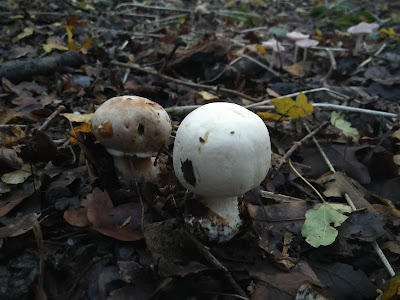SO... MANY... MUSHROOMS...
Four of us headed out on Sunday for the
Sussex Fungus Group foray at Tilgate Park, Crawley. And what a foray it was! The parkland was just heaving with mushrooms, loving the wet weather. There were new species to be seen at almost every turn.
We saw loads on the grass verges near the Nature Centre, including this
Clustered Domecap Lyophyllum decastes.
And one of those dirty-looking
Tricholomas.
Honey Fungus Armillaria mellea was out en masse.
We saw big patches of
Earthy Webcap Cortinarius hinnuleus s.l. all over the place.
C. hinnuleus is now understood to be a species complex and a number of similar-looking species with widely spaced gills have been placed in subgenus
Telamonia section
Hinnulei. I gather
they are very difficult (impossible?) to identify to species level without DNA analysis. There was an article about some of these species in Field Mycology earlier this year, here.
Oakbug Milkcap Lactarius quietus was an interesting find with its smell of bedbugs. I have no experience of what bedbugs smell like, but I recognised the smell as being the same as that of
Oily Waxcap Hygrocybe quieta, which is also supposed to smell of bedbugs. So that must be what bedbugs smell like!
One bank we walked across was covered in
Pink Gills Entoloma.
I thought I might take a closer look at this rather featureless
Entoloma when I got home. But really, that was never going to happen.
I got unduly excited about this
Inocybe that looked like a hat. But it was starting to go over, so I decided to pass on the challenge of identifying this one.
I normally ignore
Russulas because they all tend to look the same to me. But this one, growing under an ornamental oak, was so pretty I couldn't resist taking a closer look.
I'd also remembered to bring my chemicals along, so was intrigued to see what they did. This photo shows the guiac reaction (top) and the iron sulphate reaction (bottom).
A patch of perfect
Psathyrella.
The Miller Clitopilus prunulus, with its strong floury smell, like pancake batter.
Up the in old oak tree, near where the
Oak Mazegill Daedalea quercina grows, we saw what can surely only be
Beefsteak Fungus Fistulina hepatica, in the crook of a decaying limb.
When we found a different-looking
Russula, I thought I'd have another go with the chemicals and found the reactions were completely different (guiac, top; iron sulphate, bottom). Haven't got as far as figuring out what this means yet.
Lilac Fibrecap Inocybe geophylla var.
lilacina was out in quite a few spots around the park; as was
White Fibrecap Inocybe geophylla.
We came across a couple more
Russulas which I gather are 'do-able' in the field.
Charcoal Burner Russula cyanoxantha, with its oily gills.
Bloody Brittlegill Russula sanguinaria.
We found
Wrinkled Club Clavulina rugosa, which we've found previously in the Pinetum at Tilgate Park (
here).
The
Dyer's Mazegill Phaeolus schweinitzii, which we visit every year, was looking glorious in the wet weather.
Growing with it, we found the rare
Wood Bolete Buchwaldoboletus lignicola. Not a very photogenic specimen, unfortunately.
Nearby, Bleeding Oakcrust Stereum rugosum was looking impressively bleedy.
These rather bedraggled-looking parasols confused us for a moment, as nearly all their scales had washed off in the rain.
But a look at the pattern on the stem confirmed them as
Parasol Macrolepiota procera.
The exotic oyster-like mushroom that we found last year,
Hypsizygus tessulatus, was looking particularly fine in the wet weather.
En route to the Pinetum, we had
Common Puffball Lycoperdon perlatum...
.... some attractive pale grey
Amanitas. Nick Aplin was planning to take a closer look at these ones.
Another
Russula. (I don't know if I'm going to get anywhere with these, not had a chance to go through the book yet...)
The rootball of a fallen pine tree had
Cauliflower Fungus Sparassis crispa growing on it.
A standing dead stump was adorned with
Sulphur Tuft Hypholoma fasciulare and
Shaggy Scalycap Pholiota squarrosa.
Trooping along under the birch, near the lake, there was a big patch of
Birch Knight Tricholoma fulvum.
When we got to the Pinetum, Nick Aplin spotted some white 'brackets' on a fallen pine trunk which looked like a
Postia from above, but had gills. Interesting! I look forward to hearing confirmation of what these are...
Then a fine specimen of
Scarletina Bolete Boletus (or should that be
Neoboletus? I can't keep up...)
luridiformis.
We convinced ourselves we could see a few strands of violet hyphae at the base of these tall
Laccaria, making them
Bicoloured Deceiver Laccaria bicolor.
Primrose Brittlegill Russula sardonia, which had a purple-flushed stem.
And Mushroom Of The Day for me was this
Earthy Powdercap Cystoderma amianthinum.
We looked for '
the strangler' but, alas, didn't find it.
This
Yellowleg Bonnet Mycena epiterygia looked more impressive in the flesh than it does in this photo. But the stretchy cuticle was a distinctive feature.
This old bonfire site made for an impressive sight!
It was absolutely covered in
Pholiota mushrooms, with extremely gloopy ('viscid') caps.
Bonfire Scalycap Pholiota highlandensis?
Near here we had
Liver Milkcap Lactarius hepaticus, which we've had at the Pinetum before.
We weren't sure whether this rather pale
Leccinum was going to be something unusual, or not. The white flesh was unchanging when cut...
This
Milkcap Lactarius had a distinctive metallic smell, reminiscent of engine parts, railings or 'the smell of your hands after pushing a roundabout for ages'. Will have to do some work on this one...
And under the shrubs, near the stream, a small puffball. Can't remember what we thought this one might be...
Dusky Puffball Lycoperdon nigrescens?
Will do a bit more identification work with the microscope, if I get the chance.
For the record
Date: 13/10/2019
Location: Tilgate Park, Crawley
Records to be submitted via Sussex Fungus Group

























































































